|
eXplorations>The
Revolution>Teacher
Resources>The
Repeal or the Funeral of Miss Americ-Stamp
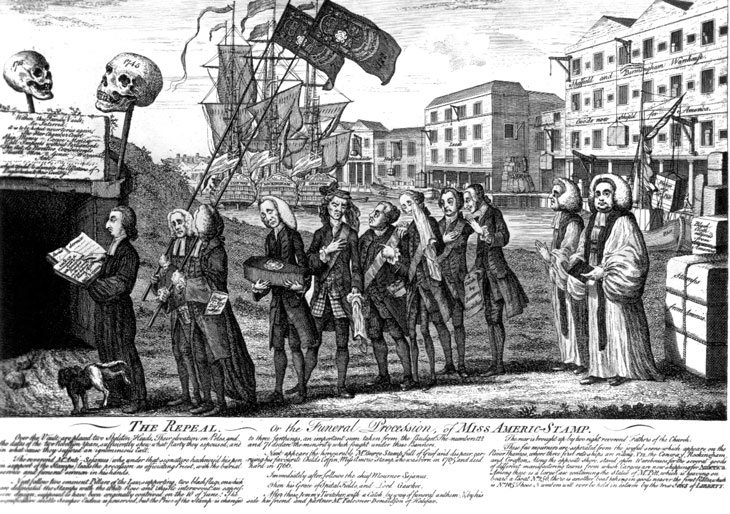
The
Repeal or the Funeral of Miss Americ-Stamp
Attributed to Benjamin Wilson (March 18, 1766)
Prints and Photgraphs Division, Library of Congress
London : Printed for & sold by Carington Bowles, No. 69 in St. Pauls Church
Yard, [1766 or later]
The text above the vault reads:
Within this Family
Vault, Lie Interred, it is to be hoped never to rise again,
The Star Chamber
Court Ship
Money
Excise Money & all Imposts without Parliament. The Act
de Haeritico Comburendo Hearth Mon Gener Warrants And which
tended to alienate
the Affections of Englishmen to their Country.
Text below the cartoon reads:
1st column:
Over the Vault are placed two Skeleton
Heads. Their elevation on Poles, and the dates of the two Rebellion
Years,
sufficiently
shew what Party they espoused, and in what cause they suffered
an ignominious Exit.
The reverend Mr.Anti-Sejanus (who under that signature hackney'd
his pen in support of the Stamps) leads the procession as officiating
Priest, with the burial service and funeral sermon in his hands.
Next follow two eminent Pillars of the Law, supporting two black
flags, on which are delineated the Stamps with the White Rose and
Thistle interwoved, an expressive design, supposed to have been
originally contrived on the 10 of June. The significative motto
Semper Eadem is preserved, but the Price of the Stamp
2nd column:
is changed
to three farthings, an important sum taken from the
Budget. The numbers 122 and 71 declare the minority which
fought under
these
Banners.
Next appears the honourable Mr. George
Stamp, full of Grief and dispair, carrying his favourite
Childs Coffin, Miss Americ Stamp,
who was born in 1763 and died hard in 1766.
Immediately after,
follows the chief Mourner Sejanus.
Then his Grace of Spital Fields, and Lord
Gawkee.
After these Jemmy Twitcher, with a Catch, by way
of funeral anthem, & by
his side his friend and partner Mr. Falconer Donaldson
of Halifax.
3rd column:
The rear is brought up by two right reverend Fathers of the Church.
These few mourners are seperated from the joyful scene which appears
on the River Thames, where three first rate ships are riding. VIZ.
the Conway, Rockingham, and Grafton. Along the opposite Shore,
stand open Warehouses, for the several goods of different manufactoring
towns from which Cargoes are now shipping for America. Among these
is a large Case containing the Statue of Mr. Pitt, which is heaving
on board a Boat No. 250, there is another boat taking in goods
nearer the first Rates, which is No. 105. These Numbers will ever
be held in esteem by the true SONS of LIBERTY.
This
cartoon, which celebrates the end of the Stamp Tax, is said to
be "one
of the most famous and popular of the political satires commenting
on
the
Stamp
Act." This print became one of the most copied satirical
prints of the time period.
| The cartoon shows a funeral procession of supporters
of the act carrying a small coffin containing the remains of
the bill toward an open vault. The vault has been prepared for
the burial of all unjust acts that would alienate Englishmen. |
| Leading the procession and preparing to deliver the funeral
eulogy is the Reverend W. Scott, who under the name "Anti-Sejanus,"
published letters in support of the Stamp Act in London's Public
Advertiser. |
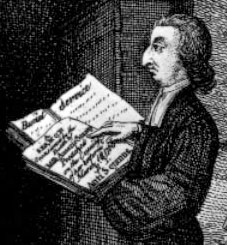
|
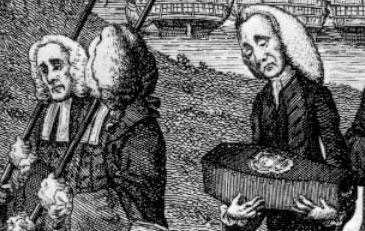 |
Scott is followed by the mourners: Solicitor General
Wedderburn and Attorney General Norton, who are mockingly referred
to as "Two Pillars of the Law" in the text.
"George Stamp" in the foreground holding the coffin,
represents George Grenville. Lord Grenville is shown "carrying
his favourite Childs Coffin, Miss Americ Stamp,
who was born in 1763 and died hard in 1766."
Following him are Bute, Bedford, and Temple,
some of the same Englishmen
who were
responsible for passing the act. |
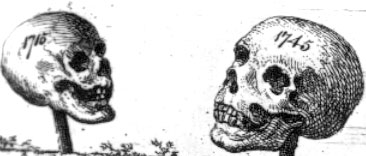 |
The dates on the skulls above the vault refer to the uprisings
by the Jacobites, supporters of King James after the Glorious
Revolution of 1688. They continued to believe that the authority
of the king came from God not Parliament. |
| The black flags carried by Wederburn and Norton
contain the numbers 71 and 122 which reference the number of
votes against
the repeal
of
the
Stamp Act in the
house of Lords and Commons. |
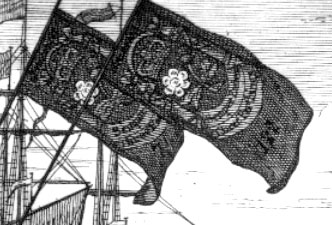 |
The ships in the background are labeled "Conway," "Rockingham," and "Grafton."
They represent the Parliamentary leaders responsible for the
repeal of the
bill now stand ready to carry the goods to America.
|
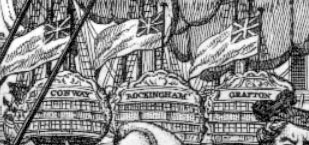 |
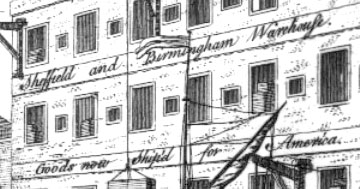 |
By setting the action on a dock, the artist
is able to show the large unshipped cargoes destined for America
that accumulated during the period when the act was in force.
|
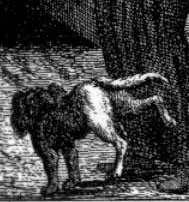 A small dog makes a gesture under
Reverend Scott. A small dog makes a gesture under
Reverend Scott. |
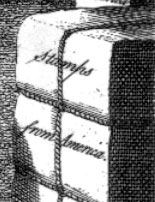 Stamps
just returned from America are also stacked on the wharf. Stamps
just returned from America are also stacked on the wharf.
Directly behind the bale of stamps, is a crate containing
a statue of William Pitt, Grenville's archenemy in the Stamp
Act controversy. |
Sources:
|
